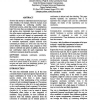Free Online Productivity Tools
i2Speak
i2Symbol
i2OCR
iTex2Img
iWeb2Print
iWeb2Shot
i2Type
iPdf2Split
iPdf2Merge
i2Bopomofo
i2Arabic
i2Style
i2Image
i2PDF
iLatex2Rtf
Sci2ools
ACL
1998
1998
Confirmation in Multimodal Systems
Systems that attempt to understand natural human input make mistakes, even humans. However, humans avoid misunderstandings by confirming doubtful input. Multimodal systems--those that combine simultaneous input from more than one modality, for example speech and gesture--have historically been designed so that they either request confwmationof speech, their primary modality, or not at all. Instead, we experimented with delaying confirmation until after the speech and gesture were combined into a complete multimodal command. In controlled experiments, subjects achieved more commands per minute at a lower error rate when the system delayed confirmation, than compared to when subjects confirmed only speech. In addition, this style of late confirmation meets the user's expectation that confirmedcommands shouldbe executable.
| Added | 01 Nov 2010 |
| Updated | 01 Nov 2010 |
| Type | Conference |
| Year | 1998 |
| Where | ACL |
| Authors | David McGee, Philip R. Cohen, Sharon L. Oviatt |
Comments (0)

